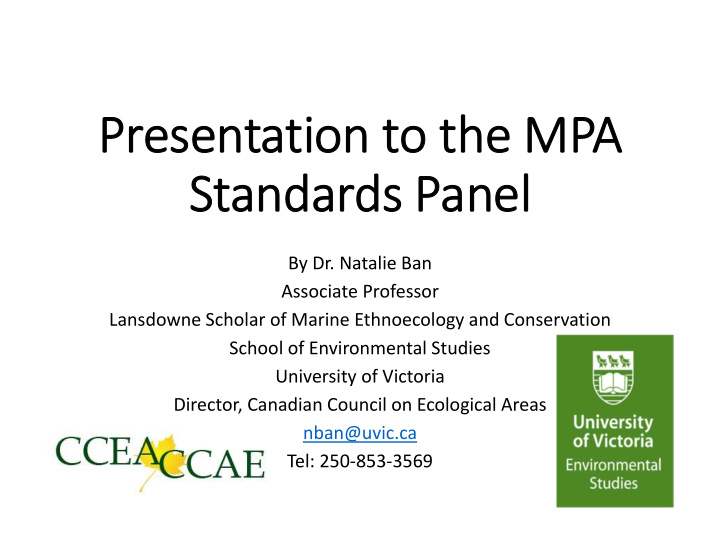



Presentation to the MPA Standards Panel By Dr. Natalie Ban Associate Professor Lansdowne Scholar of Marine Ethnoecology and Conservation School of Environmental Studies University of Victoria Director, Canadian Council on Ecological Areas nban@uvic.ca Tel: 250‐853‐3569
1. Experience around the world indicates that well‐managed marine protected areas can help safeguard ecosystems and wildlife, rebuild fish stocks, and generate increased economic opportunities. What practical recommendations do you have for creating standards for marine protected areas?
Average effectiveness Added benefit of MPAs to biodiversity 100% 80% 60% 40% 20% 0% Fished Some More No fishing fishing fishing restrictions restrictions (IUCN VI) (IUCN IV)
Average effectiveness Added benefit to biodiversity 100% 80% 60% 40% 20% 0% Fished Some More No fishing fishing fishing restrictions restrictions (IUCN VI) (IUCN IV)
Average effectiveness Added benefit to biodiversity 100% 80% 60% 40% 20% 0% Fished Some More No fishing fishing fishing restrictions restrictions (IUCN VI) (IUCN IV)
Average effectiveness Added benefit to biodiversity 100% 80% 60% 40% 20% 0% Fished Some More No fishing fishing fishing restrictions restrictions (IUCN VI) (IUCN IV)
Recommendation MPAs need to have minimum protection standards • Human activities that alter the habitat, and industrial activities, should be prohibited • The only allowable activities, in the least protective zone, should be “low‐level non industrial use of natural resources compatible with nature conservation” (IUCN Guidelines 2012) • Need standards to mandate fully protected areas (IUCN I and II) as a core part of our MPAs and MPA networks. • Standards should be set for every category of protected area • The minimum standards should also apply to Other Effective Areas‐Based Conservation Measures.
Minimum protection standards needed because: • Canada is reporting areas as protected that do not provide protections • Not having them will water down protections in terrestrial protected areas • It will facilitate stakeholder consultations and engagement in MPA and MPA network planning • Once minimum protection standards are established, sufficient resources will be needed for outreach, education, and enforcement to ensure compliance
2. What role do indigenous approaches play in shaping your suggestions? What kinds of guidelines will help Canada to honour its commitments to reconciliation and new relationships with Indigenous peoples?
Past typical size Current typical size
Photo: Tristan Blaine
Past Current typical typical catches catches
Recommendation • Follow the recommendations by the Indigenous Circle of Experts report released in late March • The recommendations apply to the marine environment • At a minimum, MPAs should be jointly managed by Indigenous peoples • Facilitate land‐sea protection
3. The IUCN has developed an existing structure to categorize marine protected areas. What do you see as the strengths and weaknesses of the IUCN Guidelines?
IUCN Guidelines Strengths • Globally consistent • Consistent across terrestrial, marine, and freshwater systems Weaknesses • Not all categories are intuitive • Based on objectives, not biodiversity outcomes
4. Overall, do the Guidelines developed by the IUCN work well in the Canadian context? 5. Are there specific circumstances unique to Canada that pose challenges for the use of the IUCN guidelines? What might these be? How should these circumstances be addressed?
Recommend
More recommend